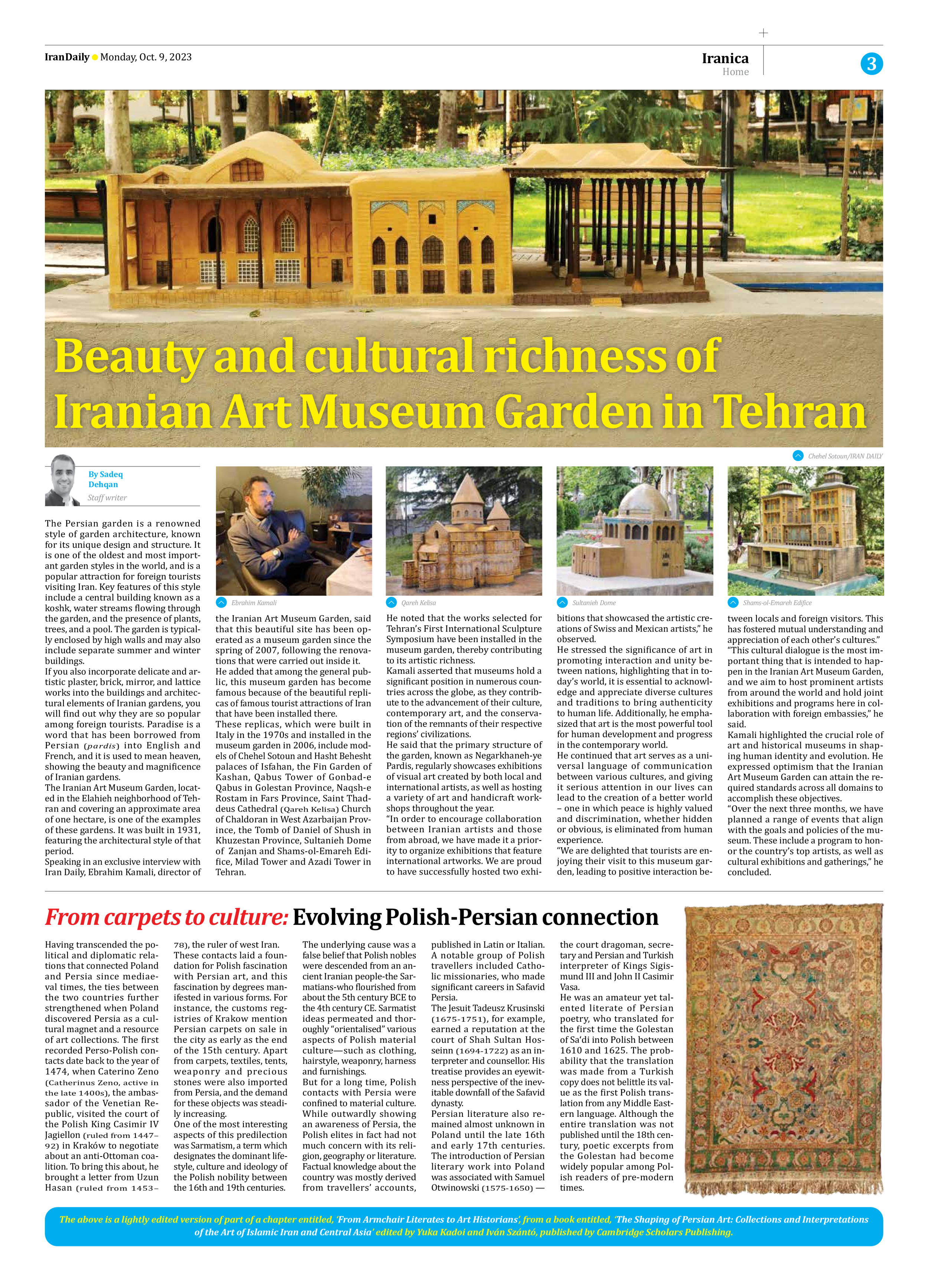
Beauty and cultural richness of Iranian Art Museum Garden in Tehran
By Sadeq Dehqan
Staff writer
The Persian garden is a renowned style of garden architecture, known for its unique design and structure. It is one of the oldest and most important garden styles in the world, and is a popular attraction for foreign tourists visiting Iran. Key features of this style include a central building known as a koshk, water streams flowing through the garden, and the presence of plants, trees, and a pool. The garden is typically enclosed by high walls and may also include separate summer and winter buildings.
If you also incorporate delicate and artistic plaster, brick, mirror, and lattice works into the buildings and architectural elements of Iranian gardens, you will find out why they are so popular among foreign tourists. Paradise is a word that has been borrowed from Persian (pardis) into English and French, and it is used to mean heaven, showing the beauty and magnificence of Iranian gardens.
The Iranian Art Museum Garden, located in the Elahieh neighborhood of Tehran and covering an approximate area of one hectare, is one of the examples of these gardens. It was built in 1931, featuring the architectural style of that period.
Speaking in an exclusive interview with Iran Daily, Ebrahim Kamali, director of the Iranian Art Museum Garden, said that this beautiful site has been operated as a museum garden since the spring of 2007, following the renovations that were carried out inside it.
He added that among the general public, this museum garden has become famous because of the beautiful replicas of famous tourist attractions of Iran that have been installed there.
These replicas, which were built in Italy in the 1970s and installed in the museum garden in 2006, include models of Chehel Sotoun and Hasht Behesht palaces of Isfahan, the Fin Garden of Kashan, Qabus Tower of Gonbad-e Qabus in Golestan Province, Naqsh-e Rostam in Fars Province, Saint Thaddeus Cathedral (Qareh Kelisa) Church of Chaldoran in West Azarbaijan Province, the Tomb of Daniel of Shush in Khuzestan Province, Sultanieh Dome of Zanjan and Shams-ol-Emareh Edifice, Milad Tower and Azadi Tower in Tehran.
He noted that the works selected for Tehran’s First International Sculpture Symposium have been installed in the museum garden, thereby contributing to its artistic richness.
Kamali asserted that museums hold a significant position in numerous countries across the globe, as they contribute to the advancement of their culture, contemporary art, and the conservation of the remnants of their respective regions’ civilizations.
He said that the primary structure of the garden, known as Negarkhaneh-ye Pardis, regularly showcases exhibitions of visual art created by both local and international artists, as well as hosting a variety of art and handicraft workshops throughout the year.
“In order to encourage collaboration between Iranian artists and those from abroad, we have made it a priority to organize exhibitions that feature international artworks. We are proud to have successfully hosted two exhibitions that showcased the artistic creations of Swiss and Mexican artists,” he observed.
He stressed the significance of art in promoting interaction and unity between nations, highlighting that in today’s world, it is essential to acknowledge and appreciate diverse cultures and traditions to bring authenticity to human life. Additionally, he emphasized that art is the most powerful tool for human development and progress in the contemporary world.
He continued that art serves as a universal language of communication between various cultures, and giving it serious attention in our lives can lead to the creation of a better world – one in which peace is highly valued and discrimination, whether hidden or obvious, is eliminated from human experience.
“We are delighted that tourists are enjoying their visit to this museum garden, leading to positive interaction between locals and foreign visitors. This has fostered mutual understanding and appreciation of each other’s cultures.”
“This cultural dialogue is the most important thing that is intended to happen in the Iranian Art Museum Garden, and we aim to host prominent artists from around the world and hold joint exhibitions and programs here in collaboration with foreign embassies,” he said.
Kamali highlighted the crucial role of art and historical museums in shaping human identity and evolution. He expressed optimism that the Iranian Art Museum Garden can attain the required standards across all domains to accomplish these objectives.
“Over the next three months, we have planned a range of events that align with the goals and policies of the museum. These include a program to honor the country’s top artists, as well as cultural exhibitions and gatherings,” he concluded.







